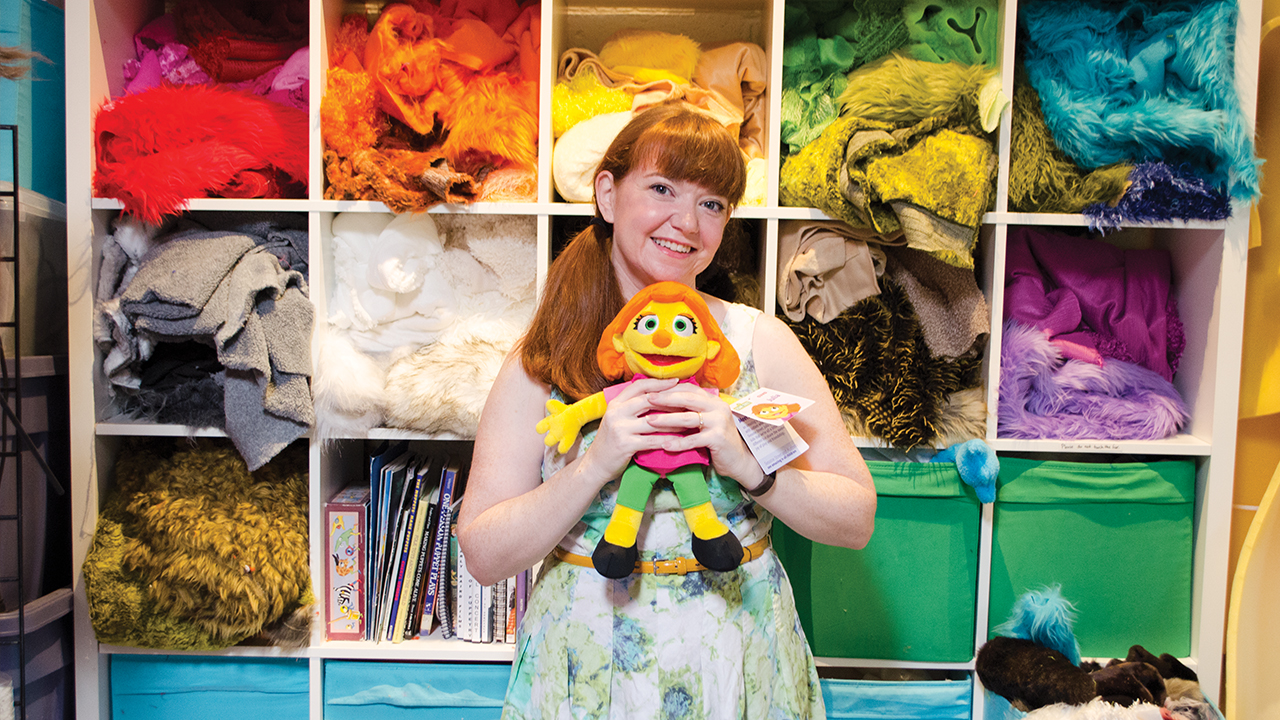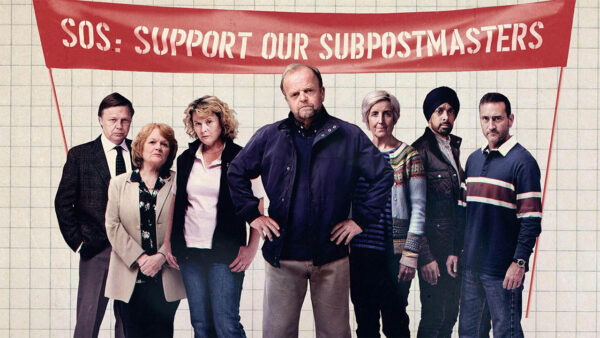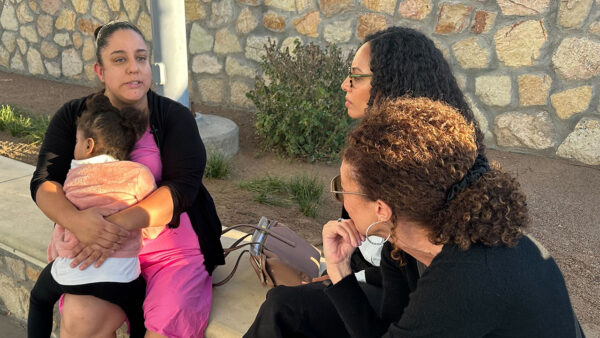 Puppeteer Stacey Gordon with Julia, the character she plays on Sesame Street.
Puppeteer Stacey Gordon with Julia, the character she plays on Sesame Street.This story was originally published in the Summer 2017 issue of Arizona PBS magazine.
Sesame Street’s newest Muppet character, Julia, is a curious little girl who has autism. And the artist who portrays her is one of our own: Phoenix-based puppeteer Stacey Gordon.
When “Sesame Street” began searching for a puppeteer for a Muppet who has autism, they naturally wanted someone who was already part of the autism community. It turned out that the perfect performer was waiting for them right here in the Valley.
Stacey Gordon, who began working with puppets as a teenager, creates and sells puppets and teaches puppeteering workshops out of her Phoenix studio, Puppet Pie, as well as performing in various local puppetry groups. She also has experience in working with autistic children. After moving to Phoenix in 2001, she worked as a habilitator, working one-on-one to teach a wide range of communication, socialization and motor skills. Her own son, now 13, also happens to be on the autism spectrum.
Gordon said that her experiences as a habilitator helped her decide what she thought Julia should sound like. “I went into my audition with the voice already developed,” Gordon said. She had been given a list of characteristics and traits that the “Sesame Street” team wanted Julia to have, and they reminded Gordon of a little girl she had worked with in Phoenix.
“One of the things we used to do to get her to use her voice was to record her,” Gordon said. “We would sing songs together and we would play it back so she could hear that her voice had power.” Because the girl’s mother saved those tapes, Gordon was able to study the cadence and singsong-y nature of her voice. “I tried to emulate her, and that helped to develop Julia’s voice,” Gordon said.
Stacey Gordon was first recommended for the job by “Sesame Street” puppeteers Leslie Carrara-Rudolph and Pam Arciero — friends she knows through the national puppetry community. “One day last year, I got a text from Leslie that said, ‘I need your contact info, I’m recommending you for something, but I can’t say why.’ And about five days later, I got an email from Sesame Street saying I’d come highly recommended and could I explain my connection to autism. I think I wrote back a novel!”

At that point, Julia had appeared in “Sesame Street” storybooks and animated videos, but Gordon didn’t yet know that a puppet was being developed. “I thought maybe they just wanted my perspective from a parent’s point of view,” she said. “They wrote back and asked me to send a video of basic puppeteering skills. And then a couple weeks later, they asked me to formally audition.”
As the parent of a child with autism, Julia’s introduction was going to be meaningful for Gordon regardless of whether she got the part. The character benefits everyone in the “Sesame Street” audience: providing inclusion for autistic children while also helping neurotypical children and parents better understand autism and how to be a good friend to autistic classmates.
And if viewers learn just one thing about autism because of Julia? “That kids with autism have valuable experience and knowledge to contribute,” Gordon said without hesitation.
Dr. Jeanette Betancourt, Sesame Workshop’s SVP of U.S. Social Impact, agrees. Bringing Julia to “Sesame Street” is part of a larger initiative called Autism: See Amazing in All Children. “Welcoming Julia to her new Sesame Street neighborhood builds on the initiative’s work of increasing understanding, reducing stigma, and demonstrating the commonalities that all children share,” Betancourt said.
Now that Gordon has learned how to get to Sesame Street, what’s it like to be there?
“It’s a dream come true,” she added. “I thought I was too short on puppeteer on ‘Sesame Street’; I had heard that you had to be very tall. So I had basically given up on that dream of being a puppeteer on the show and changed my dream to ‘well, maybe someday I’ll get to visit the set.’ My dream – to be an independent puppeteer and to have my own studio and get to be a puppeteer full time – was coming true in Phoenix at that point!” Gordon said.
As it turns out, the “Sesame” puppeteers sit on little scooters while shooting scenes with human actors, meaning that height doesn’t matter. “Working on Sesame Street is exactly how you would imagine walking into the world of Sesame Street,” Gordon said. “Everyone is positive and supportive.” There’s even a Sesame Street bowling team, she added. “And just as though we were really on Sesame Street, if you get a gutter ball, you come back and everyone’s like ‘yeah, good try!’” She laughs. “It’s magical.”

Three questions for Stacey Gordon
How do you start when you design a new puppet?
Sometimes I start with a sketch. Sometimes I will walk into SAS and rummage in furs until I find the right thing and I’ll be inspired. Sometimes I just start creating and improvise and go from there! (Improvising is the most fun, I think.)
Other than Sesame Street, what are your favorite PBS shows?
Masterpiece, especially Downton Abbey
Mercy Street
Finding Your Roots
Call the Midwife
Antiques Roadshow (My grandfather was an antiques dealer, so I’m always a fan.)
Where can readers find out more about you and your work?
facebook.com/StaceyGordonPuppeteer
facebook.com/PuppetPie
puppetpie.com
Julia photo © 2017 Sesame Workshop




















